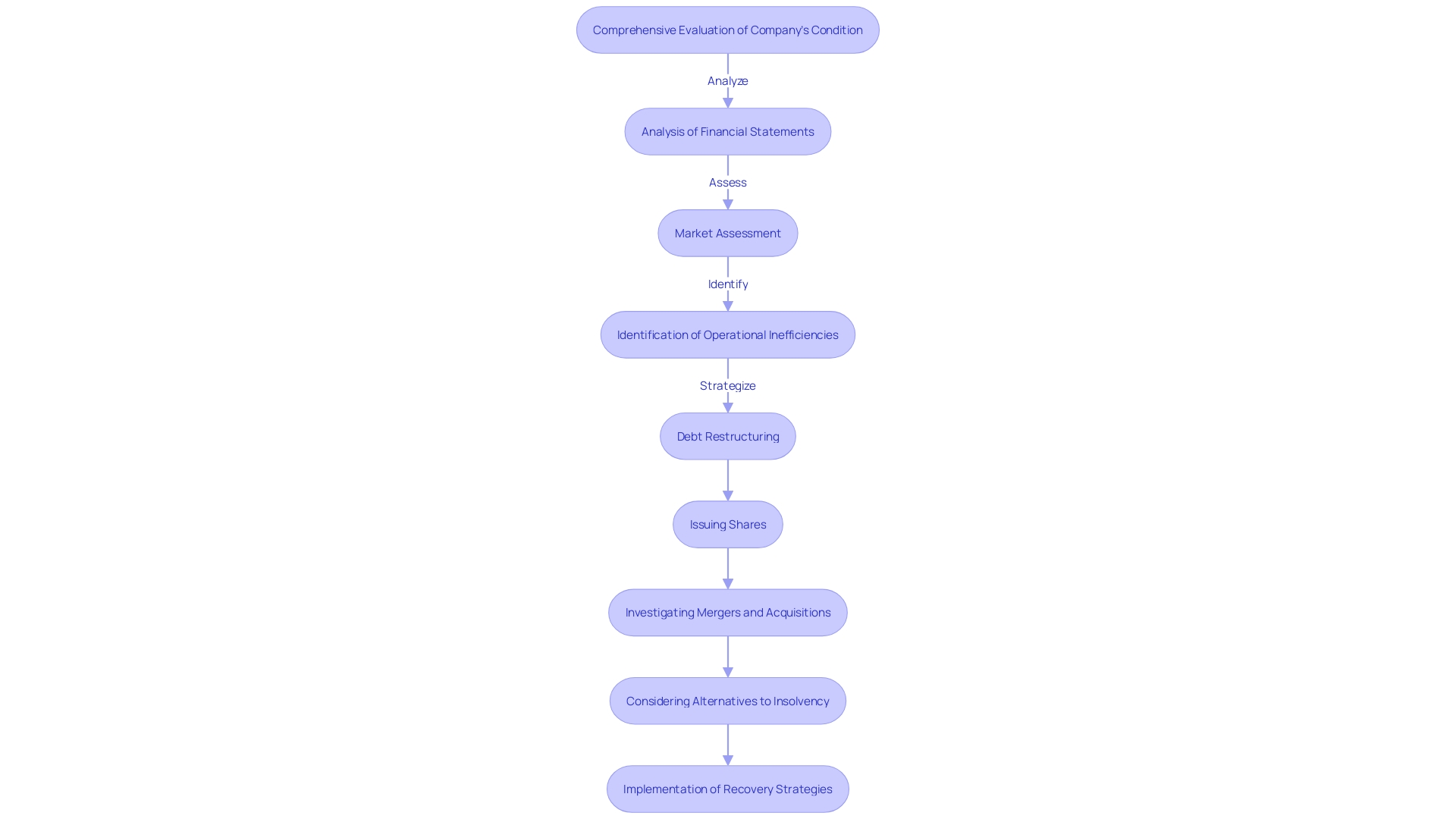Introduction
Small businesses facing financial distress often require a comprehensive approach to turn their fortunes around. This article provides practical advice and solutions for CFOs navigating the challenging task of revitalizing a struggling business. Beginning with a thorough evaluation of the current situation, including financial analysis and market assessment, CFOs can gain a comprehensive understanding of their business's health.
The next step involves developing a strategic turnaround plan, setting precise goals, and mapping out key initiatives to drive progress. Cost-cutting measures and expense optimization are crucial for enhancing profitability, while exploring various financing options can provide the necessary capital for growth. By following these actionable steps, CFOs can lead their businesses towards a successful revival.
Evaluate the Current Situation
Starting the journey towards recovery for a small enterprise in economic difficulty necessitates an essential first action: comprehensive evaluation of your company's present condition. To navigate through this challenging period effectively, you must carefully analyze your statements, including income statements, balance sheets, and cash flow statements, identifying any significant concerns and potential areas for improvement.
Understanding your competitive stance in the market is also crucial. It necessitates a sharp assessment of consumer behaviors and market trends which may be influencing your enterprise. In addition to financial and market analysis, operational efficiency should not be overlooked. Recognizing and resolving internal process bottlenecks or inefficiencies is crucial in improving your organization's performance.
These evaluations are more than just an exercise; they are essential in shaping the strategies that will rescue your struggling enterprise. As James Mohs, an associate professor at Pompea College of Business, insightfully puts it, "You always hope you can pull a rabbit out of a hat, but knowing when you can't is pivotal." This knowledge is emphasized by a sobering statistic: only 12% of entrepreneurs have reported a surge in economic growth in recent months, with 56% experiencing sluggish sales at best.
Considering these discoveries, it is evident that for enterprises of limited scale, the route to recovery may be intricate and subtle, frequently necessitating factors like restructuring debts, issuing shares, or investigating mergers and acquisitions as feasible alternatives prior to contemplating insolvency.
Despite the difficulties in the overall economic environment, where major national corporations appear to be the primary beneficiaries, Fiserv's Small Business Index provides a ray of hope, demonstrating the resilience of smaller enterprises. Additionally, grants and financial assistance, like those for obtaining vehicles, can greatly enhance operational efficiency, indicating that strategic investments and targeted aid can contribute to the transformation of a struggling enterprise.
Equipped with a thorough comprehension of your company's well-being and the wider economic climate, you can make informed choices that guide your organization towards a successful transformation.

Develop a Turnaround Plan
Creating a thorough recovery strategy is essential for saving a struggling small enterprise. It's not just about corrective actions; it's about a strategic, data-driven approach that has been proven to transform companies. Begin by establishing specific objectives that are customized to the distinct obstacles and possibilities your enterprise encounters. These should be quantifiable to track progress effectively.
Next, map out the key initiatives that will drive these goals forward. For a restaurant struggling with sales in a bustling city center, for example, capitalizing on location to boost diner traffic proved to be a game-changer. Align your strategies with market demands, whether that's cost reduction, revenue enhancement, operational tweaks, or marketing campaigns.
A timeline is indispensable. It keeps the recovery process on track and maintains momentum. For example, obtaining a vehicle grant could be a crucial step for enterprises requiring operational efficiency. With clear milestones, you can measure progress and make necessary adjustments on the fly.
Keep in mind, a conventional plan is not only a formality for lenders and investors; it's a testament to your thorough preparation. A well-designed plan clarifies your vision, differentiators, target market, and the financial trajectory. It should encompass critical sections like the executive summary, company description, and a detailed marketing and sales strategy.
In a landscape where over 33.2 million enterprises compete for success in the U.S. alone, and with a mere 25% surviving beyond 15 years, a structured and strategic turnaround plan is not just helpful—it's essential for long-term viability.

Cut Costs and Optimize Expenses
Reviving a struggling small business frequently depends on the capacity to wisely reduce expenses and streamline spending. A meticulous evaluation of overhead can uncover opportunities for expense reduction in areas such as rent, utilities, and office supplies, allowing for negotiation of more favorable terms or the pursuit of alternative options. Inventory management requires a careful examination to minimize holding expenses and improve turnover by addressing surplus or languishing stock. Operational efficiency is another frontier for savings, where automation, the elimination of redundant tasks, and better resource allocation can lead to significant improvements.
Adhering to cost-cutting measures requires a delicate balance; it's not just about slashing expenses. The process must be navigated without increasing risk, compromising compliance, or diminishing customer satisfaction. Innovative solutions, including technology, can contribute to lowering expenses without compromising the excellence of the offering. Moreover, eco-friendly initiatives can not only lead to savings but also bolster the company's commitment to social responsibility.
The pursuit of external funding through grants is an often-overlooked strategy. Business grants represent a form of 'free money' that doesn't require repayment, providing an alternative to traditional funding methods. For enterprises in specific fields, like the beauty sector, grants can play a crucial role in development, encompassing expenses from buying equipment to expanding initiatives.
From a statistical perspective, the longevity of enterprises of a modest size is a daunting prospect, with only a quarter persisting beyond 15 years. With over 33.2 million small enterprises in the United States alone, the necessity for strong expense control is evident. Maintaining operating expenses, such as payroll, inventory, insurance, and bills, at a minimal fraction of incoming revenue is essential for ensuring success. Reducing these expenses can optimize profits, maintain current expenses in control, and sustain the enterprise even in unstable markets.
James Mohs, an associate professor at Pompea College of Business, emphasizes the importance of recognizing when other monetary avenues have been exhausted, suggesting that bankruptcy should be a last resort after exploring options such as refinancing, stock issuance, or leveraging personal networks. Essentially, the core of a small enterprise's transformation rests on strategic expenditure control, inventive cost-cutting methods, and exploring all avenues of funding to guarantee a sturdy economic base.
Explore Financing Options
Obtaining funding for your company is a crucial move in navigating a monetary turnaround. With a comprehensive strategy, even enterprises facing severe liquidity challenges can find a lifeline to recovery. Consider these actionable avenues to infuse your business with the necessary funds:
-
Traditional Bank Loans: Your business might benefit from a conventional loan with a solid business plan and financial projections. Banks are often receptive to lending when presented with a credible plan for profitability and growth.
-
Government Grants and Loans: Access government-funded programs that cater to small enterprises in distress. These initiatives often support enterprises that contribute to economic growth and innovation. For example, the Small Business Innovation Research (SBIR) program is designed to assist enterprises that are pioneering new technologies.
-
Crowdfunding and Peer-to-Peer Lending: Utilize the power of the crowd. Online platforms present a unique opportunity to showcase your enterprise to potential investors and lenders. With a strong pitch and strategic marketing, you can attract funding from individuals who believe in your vision.
-
Venture Capital and Angel Investors: Engage with venture capitalists or angel investors who are in search of promising startups to invest in. While they seek significant returns, they also bring expertise and networks that can be priceless to your company.
-
Reinvestment by Partners: If you have partners in your enterprise, consider a reinvestment strategy. Partners who are deeply invested in the success of the company, like the co-owner of Capital BBQ, can provide not only capital but also innovative ideas and expertise to help steer the company back to profitability.
-
Internal Cash Flow Optimization: Sometimes the required capital can be unlocked from within your organization by optimizing existing operations and resources. Analyze every facet of your enterprise for potential savings and enhanced cash flow management.
-
Asset Refinancing or Sale: Explore the possibility of refinancing existing assets or even selling non-essential assets to unlock capital. This can provide a quick influx of cash without the need to take on new debt.
Utilize these options to obtain the required capital to support your company's expansion and overcome financial challenges. Remember, the key is to approach financing with a strategic mindset and a clear understanding of the implications each option has for the future of your business.

Conclusion
In conclusion, revitalizing a struggling small business requires a comprehensive approach and strategic decision-making. Evaluating the current situation is the first step, involving a thorough analysis of financial statements, market trends, and operational efficiency. With a clear understanding of the business's health, CFOs can make informed decisions to drive progress.
Developing a turnaround plan is crucial for success. Setting precise goals and mapping out key initiatives aligned with market demands will help steer the business in the right direction. A well-crafted business plan is not just a formality but an essential tool to showcase thorough preparation and ensure long-term viability.
Cutting costs and optimizing expenses are vital for improving profitability. CFOs must strike a balance between reducing expenses and maintaining compliance and customer satisfaction. Exploring innovative solutions, leveraging technology, and pursuing external funding through grants can provide alternative options for cost reduction and growth.
Exploring financing options is pivotal in navigating financial distress. Traditional bank loans, government grants, crowdfunding, venture capital, reinvestment by partners, and internal cash flow optimization are actionable avenues to secure the necessary capital. CFOs should approach financing with a strategic mindset and a clear understanding of the implications for the future of the business.
By following these practical steps and solutions, CFOs can lead their struggling businesses towards a successful revival. The path to turnaround may be complex, but with confidence and action-oriented decision-making, small businesses can overcome financial distress and thrive in the long run.
Take action now and lead your struggling business towards a successful revival.




